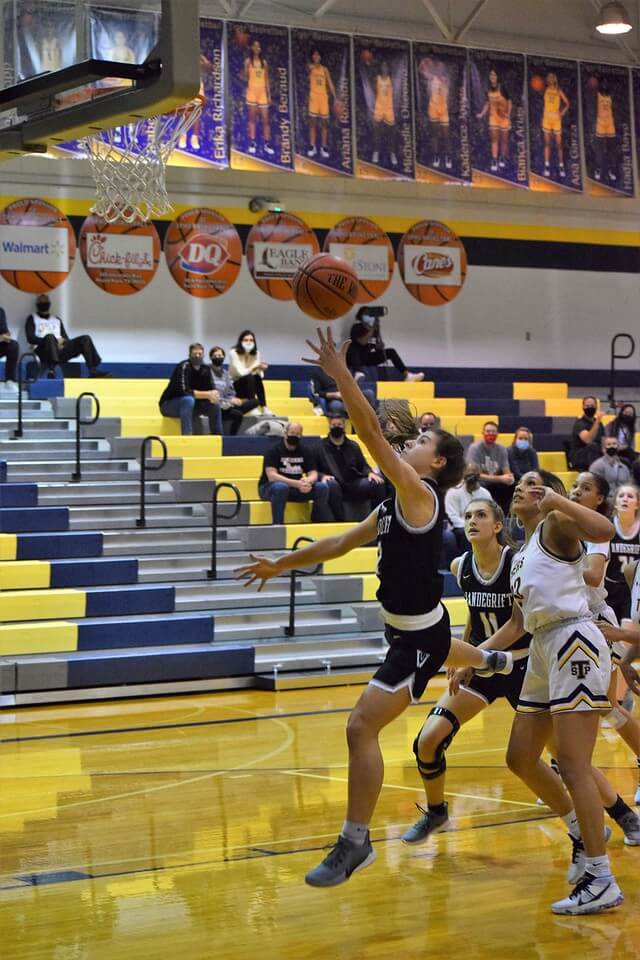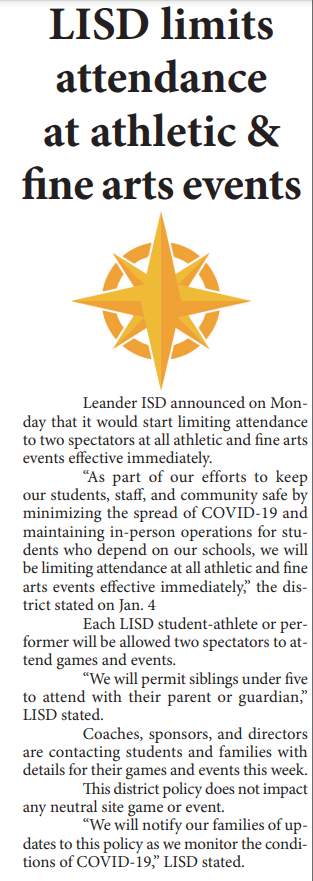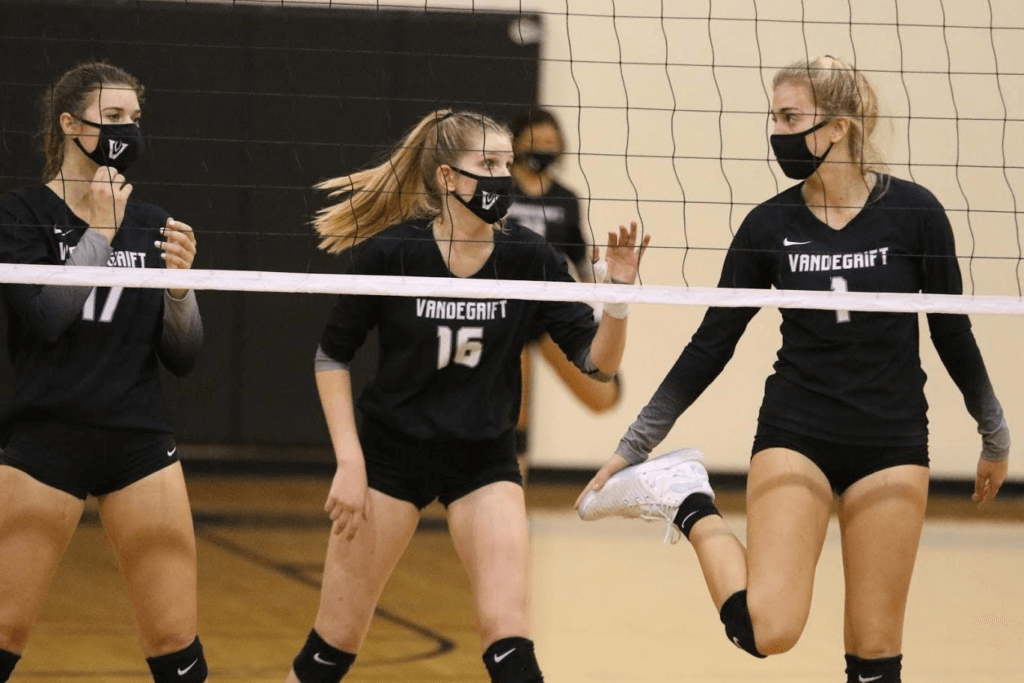
By MELISSA B. TABOADA, Texas Tribune
The COVID-19 pandemic has prompted some states to delay or cancel indoor sports, but Texas has moved forward with them. Volleyball just wrapped up its season and basketball is underway. Wrestling, one of the closest contact sports, is slated to begin in February.
Leander ISD announced on Monday that it would start limiting attendance to two spectators at all athletic and fine arts events effective immediately due to COVID.
As COVID-19 cases have resurged across the state and country, some medical experts concerned about increased risks of virus transmission related to indoor sports are advising students not to participate in them.
School districts should “not do it until we can get the pandemic under better control,” said Dr. Tina Tan, professor of pediatrics at the Northwestern University Feinberg School of Medicine, where she also serves as a pediatric infectious diseases attending physician. Players aren’t wearing masks but are breathing heavily and are able to produce smaller droplets that stay in the air longer, Tan said, increasing the risk of transmitting the virus to others. Despite the arrival of the COVID-19 vaccine, it will be months before it’s widely available to everyone in the public.

“Everybody is rushing to do this and they’re not thinking about the consequences of doing it,” she said. “Right now COVID is surging everywhere in the country. You’re going to have to wait until the rates get lower and enough people are vaccinated that the amount of transmission is happening is less … These particular activities are increased risk factors for individuals spreading COVID.”
A couple of weeks ago, the American Academy of Pediatrics put out new guidelines recommending students participating in indoor sports wear face masks. The organization said school administrators must consider the mounting evidence regarding COVID-19 in children and adolescents, including the role they may play in transmitting the infection.
As of Dec. 24, more than 2 million children in the United States had tested positive with COVID-19 since the onset of the pandemic, with 1 million of those cases since mid-November. The total number of children who contracted the virus represents 12.4% of all cases, according to data from the American Academy of Pediatrics and the Children’s Hospital Association.
While the death rate among children remains less than 1%, an increasing number of children are requiring hospitalization, Tan said.
“Teachers are getting sick, some of the students are getting sick and trying to do these indoor sports is only going to increase the risk for more people getting sick from this,” Tan said.
The number of Texas students who have been confirmed positive for COVID-19 has steadily risen since schools reopened their doors to in-person learning. Weekly state data ending Dec. 20 showed 4,406 new confirmed COVID-19 cases among students in Texas schools, bringing the cumulative number of student infections to 62,675, 2% of the nearly 2.9 million students who are learning in-person or participating in extracurricular activities on campus.
Austin Public Health Interim Medical Director and Health Authority Dr. Mark Escott in public updates in December said cases related to schools continue to be tied to extracurricular activities and social events outside of school. In previous months, more than once, he pointed to football and related strength and conditioning to prepare for the sport as the culprit for COVID-19 cases at Austin-area schools.
Last week, he recommended Austin-area middle and high schools be taught virtually only for two weeks after the winter break to prevent the spread of the virus as cases surge. He also called on school districts to suspend or postpone extracurricular activities, particularly those for which masks cannot be worn and distance cannot be maintained.
“With the positivity data we’re seeing, and the impact on hospitalization admissions and our ICUs, it’s time to scale back the risk,” Escott said last week.
In mid-December, Escott told Travis County officials the primary concern related to risks in schools is extracurricular activities.
“By and large, that is where we are seeing disease spread,” Escott said. But advocates say districts and families must weigh the increasing number of students nationwide who are fighting mental health issues associated with the pandemic and said students should continue to play. Students have reported increased feelings of anxiety and depression, and mental-health emergency room visits, as well as thoughts of suicide and suicide attempts, are on the rise.
Other states, like Colorado, have pushed off winter sports, with no hard timeline on when they can begin.
But state and school officials in Texas say they’ve taken steps to mitigate the risks of transmission. Students wear masks while on the bench or not actively playing and many are not riding on buses to the games. Players put on hand sanitizer each time they step off court and the playing ball is sanitized and swapped out multiple times during a game.
Schools also limit and spread out spectators, or don’t allow them in games at all. And student athletes have forgone the tradition of shaking hands with opposing team players at the conclusion of the game.
Guidelines by Texas’ University Interscholastic League, which oversees school extracurricular academic and athletic contests, requires masks for spectators and for students who are not actively participating in competition or at practice. It’s up to local districts, however, to determine whether students must wear them while playing.
“The masking exception that we (have), we have school districts around the state that conveniently enough, it happens that the entire student athlete population has a medical illness that prevents them from wearing a mask when they’re participating in activities,” Escott said in mid-December. “I hear from parents of our local basketball players who are upset because their school district, their basketball team, requires that masks be worn during basketball games yet the opposing team has no masks because we don’t have the ability to enforce that.”
Jamey Harrison, the UIL’s deputy executive director, said participation in sports and other extracurricular activities is a valuable experience particularly “in a year that students are facing challenges and mental health challenges that they’ve never faced before.”
Melissa B. Taboada is an Austin-based freelance writer. If you have feedback or a tip related to this story, email editors@texastribune.org. The Texas Tribune is a nonpartisan, nonprofit media organization that informs Texans — and engages with them – about public policy, politics, government and statewide issues.
Leander ISD announced on Monday that it would start limiting attendance to two spectators at all athletic and fine arts events effective immediately.
“As part of our efforts to keep our students, staff, and community safe by minimizing the spread of COVID-19 andmaintaining in-person operations for students who depend on our schools, we will be limiting attendance at all athletic and fine arts events effective immediately,” the district stated on Jan. 4
Each LISD student-athlete or performer will be allowed two spectators to attend games and events.
“We will permit siblings under five to attend with their parent or guardian,” LISD stated.
Coaches, sponsors, and directors are contacting students and families with details for their games and events this week.
This district policy does not impact any neutral site game or event.
“We will notify our families of updates to this policy as we monitor the conditions of COVID-19,” LISD stated.


